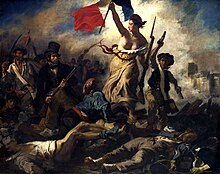The Progress of Liberty



The Progress of Liberty – poemat osiemnastowiecznej angielskiej poetki Mary Robinson (1758–1800)[1][2], napisany w 1798[3] i opublikowany pośmiertnie w 1801[4]. Utwór jest napisany wierszem białym (blank verse)[5], czyli nierymowanym pentametrem jambicznym[6][7], to znaczy sylabotonicznym dziesięciozgłoskowcem[8], w którym akcenty padają na parzyste sylaby wersu. Utwór rozpoczyna się inwokacją do Wolności:
- Hail, Liberty sublime ! hail godlike pow'r,
- Coëval with the skies, to earth new born;
- Thou parent of delight, thou source refined
- Of human energy! Thou fountain vast
- From whose immortal stream the soul of man
- Imbibes celestial fervour ! But for thee,
- O ! best and noblest attribute of God!
- Who would the coil endure of mortal woe.
- The frowns of fortune, or the taunts of pride;
- Float with the gale, or buffet with the storm;
- Who labour thro' the busy dream of time.
- War with oppression, or resist the base;
- Opposing ever, and by each oppos'd.
- To count succeeding conflicts; and to die?
- Hail, Liberty! legitimate of Heav'n!
Poemat składa się z dwóch ksiąg i zajmuje około pięćdziesięciu stron druku. Początkowo składające się na poemat teksty były od kwietnia do maja 1798 wydawane jako części cyklu zatytułowanego Poetic Pictures. Nosiły tytuły wtedy The Birth-day of Liberty, The Progress of Liberty, The Horrors of Anarchy, The Vestal, The Monk i The Dungeon[9].
Przypisy
[edytuj | edytuj kod]- ↑ Robinson, Mary, w: 1911 Encyclopædia Britannica, Volume 23. en.wikisource.org. [dostęp 2017-02-03]. (ang.).
- ↑ Robinson, Mary (1758-1800), w: Dictionary of National Biography, 1885-1900, Volume 49. en.wikisource.org. [dostęp 2017-02-03]. (ang.).
- ↑ Dustin Griffin: Patriotism and Poetry in Eighteenth-Century Britain. books.google.pl, 2002. s. 290. [dostęp 2017-02-03]. (ang.).
- ↑ Mary Robinson: Mary Robinson: Selected Poems. books.google.pl, 2000. s. 298. [dostęp 2017-02-03]. (ang.).
- ↑ Joseph Berg Esenwein, Mary Eleanor Roberts: The Art of Versification. Archive.org, 1920. s. 133-139. [dostęp 2017-02-03]. (ang.).
- ↑ blank verse, [w:] Encyclopædia Britannica [dostęp 2017-02-03] (ang.).
- ↑ Blank Verse. dictionary.com. [dostęp 2017-02-03]. (ang.).
- ↑ Blank verse. PoetryFoundation.org. [dostęp 2017-02-03]. (ang.).
- ↑ Jason R. Rudy: The Electric Poetess: Robinson, Hemans, and the Charge of Romanticism, w: Electric Meters: Victorian Physiological Poetics. ohioswallow.com, 2009. s. 32. [dostęp 2017-02-03]. (ang.).
Bibliografia
[edytuj | edytuj kod]- Mary Robinson: The poetical works of the late Mrs. Mary Robinson: including many pieces never before published. In three volumes. Volume III. Archive.org, 1806. s. 1-52. [dostęp 2017-02-03]. (ang.).
Linki zewnętrzne
[edytuj | edytuj kod]- Shelley A.J. Jones: Revising for Genre: Mary Robinson's Poetry from Newspaper Verse to Lyrical Tales. scholarcommons.sc.edu, 2014. [dostęp 2017-02-03]. (ang.).
- Daniel Robinson: The Poets "Perplext": Southey and Robinson at Work on the "Morning Post". jstor.org, 2011. [dostęp 2017-02-03]. (ang.).
